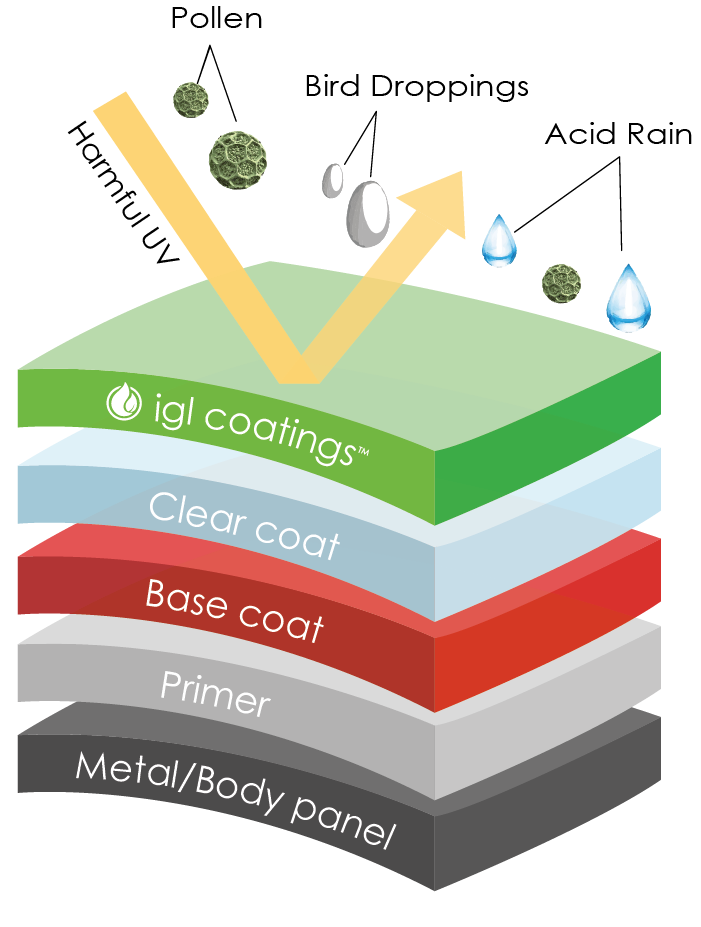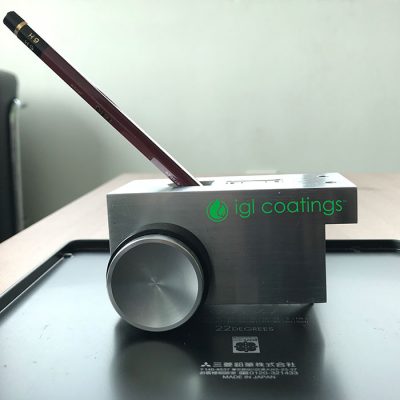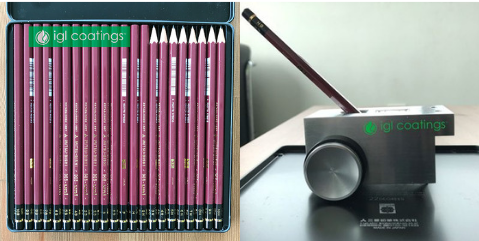Coatings on Substrate
Coatings are usually very thin layers of materials supported by a substrate. Anything laid on top of a substrate is a coating, this includes waxes, lacquer/acrylic/enamel paints, and other types of material coated on a substrate.
A coating that is applied on a hard base will naturally increase the hardness of the coating. As you can see in the image below, the ceramic coating will form a layer on your car’s clear coat that will help protect the surface from things like harmful UV, Pollen, bird droppings, acid rains among other external elements that damage your car’s paint.
Wanna read the full list of things that ceramic coating can benefit you? check out this ceramic coating benefits article

What is Hardness?
Hardness is the resistance of a solid material to deformity when a compressive force is applied. Certain materials (e.g. metals) are harder than others (e.g. plastics). Macroscopic hardness is generally characterised by strong intermolecular bonds, but the behaviors of solid materials under force is much more complex; therefore, there are different measurements of hardness:
- scratch hardness
- indentation hardness
- rebound hardness.
Hardness is highly dependent on ductility, elastic stiffness, plasticity, strain, strength, toughness, viscoelasticity, and viscosity.
Scratch Hardness Scale Types
In this article, we will zoom in on Scratch Hardness. These tests are used to determine the hardness of a material to scratches and abrasion.
Generally, there are 3 scales used for determining the hardness of mineral:
- Mohs Scale: It is based on relative scratch hardness, with talc assigned a value of 1 and diamond assigned a value of 10. Mohs’ scale had two limitations; it was not linear, and most modern abrasives fall between 9 and 10.
- Ridgway’s Scale: A modification of the Mohs scale by giving garnet a hardness of 10 and diamond a hardness of 15.
- Wooddell’s Scale: Extension of the Ridgway’s scale by using resistance to abrasion, and extrapolating the scale based on seven for quartz and nine for corundum, resulting in a value of 42.4 for South American brown diamond bort.
Pencil Hardness Scale: How does it work
The Mineral Scales (Mohs, Ridgway, and Wooddell) are not very suitable to be used with coatings or films. Hence the standardised ASTM Method of measuring film by using Pencil Hardness Scale is created. The pencil is made of Graphite which only rates 1-2H on the Mohs scale. Think of the Pencil Hardness scale as a detailed hardness scale for the Graphite.
Pencil hardness measurements have been used by the coatings industry for many years to determine the hardness of clear and pigmented organic coating films. This test method has also been used to determine the cure of these coatings, especially when forced dried using heat.
This test method is especially useful in developmental work and in production control testing in a single laboratory. It should be recognized that the results obtained may vary between different laboratories when different pencils, as well as panels, are used. Every effort should be made to standardize the hardness of the lead used and the technique followed.

It is also important to note that the pencil hardness test is only one of many tests used to evaluate coatings. There is more than the hardness of any coating to be considered, so do not judge a finish entirely on the basis of its hardness.
Grading pencils come in an assortment of both hard and soft and can be found in most art or office supply stores, ranging in hardness from 10H to 9B. The ‘H’ stands for hardness, the ‘B’ stands for blackness, and HB is for hard and black pencils.
The hardest is a 10H, followed by 9H, 8H, 7H, 6H, 5H, 4H, 3H, 2H, and H. F is the middle of the hardness scale; then comes HB, B, 2B, 3B, 4B, 5B, 6B, 7B, 8B, and 9B, which is the softest. The most commonly used writing pencil is the #2 (HB grade), which is fairly soft, contains more graphite, and leaves a dark mark.


How a Pencil Hardness Test is done
Usually the coating thickness being tested is 25.4-38.1 micron and has been allowed to dry for 7 days. The ambient temperature during the test can also be a factor in the drying times and can have an effect on the coating’s hardness.
A pencil is selected and a line about 1/2-inch long is made. If the pencil scratches the surface of the coating, then a softer pencil is used until we acquire the first pencil that doesn’t scratch the coating.
The test is repeated to make sure that the result is repeatable. There are also some coatings so hard that the 10H pencil won’t scratch them-these coatings are rated 10H rating to designate their hardness.
Use this chart only as a guide. It is also important to understand that the degree of hardness of any generic coating may not always be the same; in other words, if one company has a polyurethane with a 3H hardness, do not assume that every other polyurethance will have a 3H hardness. They won’t; they will vary from manufacturer to manufacturer, and from product to product.
As mentioned above, the pencil hardness test is only one of many tests that are done to evaluate a coating’s performance. Other tests such as abrasion, reverse impact resistance, direct impact resistance, cross-hatch adhesion, oxidation, gloss retention, UV resistance, yellowing, blistering, drying times, chemical/solvent resistance, salt spray resistance, humidity resistance, acid and caustic resistance, the VOC and HAP contents, and so on are also very crucial in a coating’s performance.
Before you go, I will leave you with this video that shows in practice how a pencil hardness test is done on surfaces.
About IGL Coatings
Established in 2015, IGL Coatings quickly gained traction to become one of the most trusted names in the automotive detailing industry worldwide. From Malaysia, IGL’s reach and worldwide success can be attributed to its commitment and dedication towards innovation, sustainability, customer satisfaction and technology.
IGL Coatings is a global market leader in the development and manufacturing of innovative surface protection solutions. With a strong commitment to research and development. IGL Coatings creates industry-leading coatings that deliver exceptional durability, enhanced aesthetics, and environmental sustainability. Trusted by professionals and enthusiasts worldwide. IGL Coatings dedicates itself to revolutionizing the automotive, marine, and industrial sectors with cutting-edge technologies and unparalleled customer support.
For more information about IGL Coatings and their range of automotive and marine products, please visit www.iglcoatings.com.


